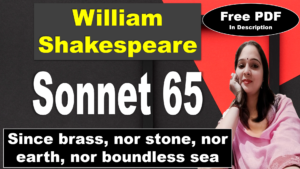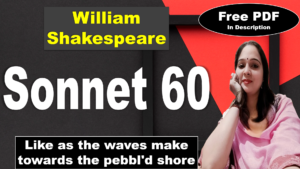Poetic Devices
Coleridge employs a range of poetic devices in The Rime of the Ancient Mariner to enhance its meaning, musicality, and emotional impact. Below are some of the key poetic devices used throughout the poem:
1. Imagery:
Coleridge’s vivid imagery helps readers visualize the scenes and events. He describes the natural world, supernatural elements, and the emotional states of characters with powerful images.
Example: “The ice was here, the ice was there, / The ice was all around: / It cracked and growled, and roared and howled, / Like noises in a swound!”
This creates a sensory-rich image of the icy environment, enhancing the reader’s sense of isolation and fear.
2. Symbolism:
Symbols play a crucial role in conveying deeper meanings. The Albatross is a symbol of nature and innocence. Its death signifies the Mariner’s sin, and the bird’s body hung around his neck represents guilt and the burden of sin.
Example: The Albatross: It symbolizes the sacredness of nature and its connection to the divine. The Mariner’s killing of the bird leads to his downfall, symbolizing humanity’s disregard for nature.
3. Repetition:
Repetition emphasizes key ideas, heightening tension and mood. Coleridge uses repeated words or phrases to create a rhythmic, haunting effect and to stress the emotional state of the characters.
Example: “Water, water, every where, / Nor any drop to drink.”
The repetition underscores the irony and desperation of being surrounded by water but unable to quench their thirst.
4. Alliteration:
Alliteration is the repetition of consonant sounds, which enhances the musical quality of the poem and draws attention to particular phrases or themes.
Example: “The fair breeze blew, the white foam flew, / The furrow followed free.”
The repeated “f” sounds create a sense of flow and movement, reflecting the ship’s swift sailing.
5. Assonance:
Assonance, the repetition of vowel sounds within words, adds to the musicality and mood of the poem.
Example: “Alone, alone, all, all alone, / Alone on a wide wide sea!”
The repetition of the “o” sound conveys the Mariner’s deep sense of isolation and despair.
6. Personification:
Coleridge frequently personifies nature, giving human qualities to elements like the wind, sun, and storm. This makes nature an active force in the poem, capable of punishing or helping the Mariner.
Example: “The Sun came up upon the left, / Out of the sea came he!”
Here, the Sun is personified, depicted as rising with intention, almost as if it has its own will.
7. Rhyme Scheme:
The poem follows a varied rhyme scheme, predominantly a loose ballad form with alternating rhyme (ABCB), though this can shift. The rhyme scheme enhances the narrative flow and the oral storytelling quality of the poem.
Example:
“He holds him with his skinny hand,
‘There was a ship,’ quoth he.
‘Hold off! unhand me, grey-beard loon!’
Eftsoons his hand dropt he.”
8. Meter:
The poem is written primarily in quatrains of alternating tetrameter and trimeter (four-beat and three-beat lines), which gives it a ballad-like rhythm suitable for oral recitation. The rhythm contributes to the poem’s eerie, haunting quality.
9. Internal Rhyme:
Internal rhyme is the use of rhyming words within a line. This adds to the musicality of the poem and makes it more engaging.
Example: “The guests are met, the feast is set.”
The internal rhyme of “met” and “set” adds a harmonious effect to the line.
10. Anaphora:
Anaphora is the repetition of a word or phrase at the beginning of successive lines or sentences, which builds intensity or emphasis on a particular theme or emotion.
Example: “Day after day, day after day, / We stuck, nor breath nor motion.”
The repetition of “day after day” conveys the unending monotony and hopelessness of the sailors’ plight.
11. Onomatopoeia:
Onomatopoeic words mimic the sounds they describe, adding a layer of auditory imagery to the poem.
Example: “It cracked and growled, and roared and howled.”
These words mimic the sounds of the ice, making the scene more immersive.
12. Supernatural Elements:
Coleridge uses supernatural elements, like ghost ships, spirits, and the resurrection of the dead, to create an eerie and mystical atmosphere. These devices make the story more captivating and highlight the moral lessons of the poem.
Example: The ghostly crew and the Spirit that drives the ship are supernatural figures that intervene in the Mariner’s fate.
13. Allusions:
Coleridge makes allusions to Christian themes and symbols throughout the poem, such as sin, penance, and redemption. The Mariner’s killing of the Albatross is reminiscent of the biblical Fall, and his eventual redemption parallels Christian salvation.
Example: The phrase “He loved the bird that loved the man / Who shot him with his bow” can be seen as an allusion to the idea of Christ’s love for humanity despite their sins.
14. Contrast:
Coleridge often uses contrast to heighten the dramatic tension in the poem, particularly between states of calm and chaos, or life and death.
Example: The dead men who rise and work on the ship without speaking create a stark contrast between life and death, enhancing the eerie atmosphere.
15. Hyperbole:
Hyperbole, or exaggerated statements, is used to create a sense of the overwhelming magnitude of the Mariner’s experience and emotions.
Example: “A thousand thousand slimy things / Lived on; and so did I.”
The phrase “a thousand thousand” is an exaggeration meant to convey the vastness of the ocean’s creatures.
16. Irony:
Coleridge uses irony to enhance the poem’s themes, particularly in the Mariner’s situation. The irony of being surrounded by water but unable to drink it highlights the Mariner’s punishment.
Example: “Water, water, everywhere, / Nor any drop to drink.”
The irony here emphasizes the Mariner’s suffering and the consequences of his actions.
17. Simile and Metaphor:
Similes and metaphors are used to compare the Mariner’s experiences to more familiar images, making abstract or complex emotions easier to understand.
Example of Simile: “The ship drove fast, loud roared the blast, / And southward aye we fled. / And now there came both mist and snow, / And it grew wondrous cold: / And ice, mast-high, came floating by, / As green as emerald.”
The ice is compared to emerald, highlighting its strange, otherworldly beauty.
Example of Metaphor: The “Albatross around the neck” is a metaphor for the burden of guilt the Mariner carries after killing the bird.
18. Pathetic Fallacy:
Coleridge uses pathetic fallacy, attributing human emotions to nature, to reflect the mood or inner state of the Mariner.
Example: The stormy weather reflects the turmoil of the Mariner’s guilt and the chaos that follows his crime.
Conclusion:
Coleridge’s The Rime of the Ancient Mariner is rich in poetic devices that enhance the poem’s meaning, tone, and emotional depth. Through the use of imagery, symbolism, meter, and other devices, he creates a vivid and compelling narrative that engages the reader and reinforces the poem’s moral and thematic messages.










